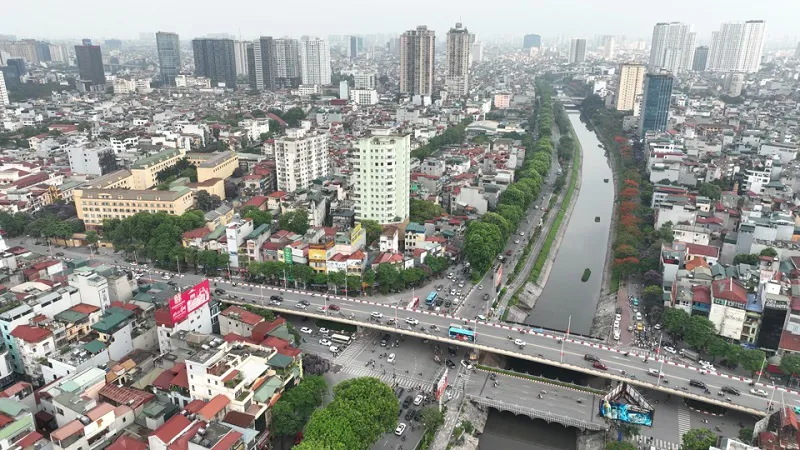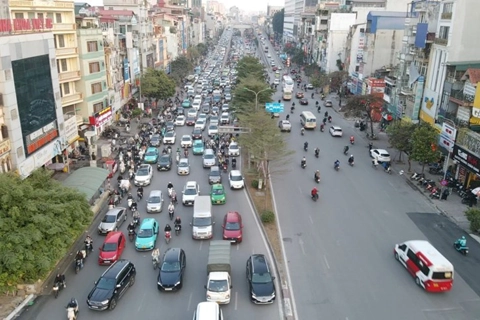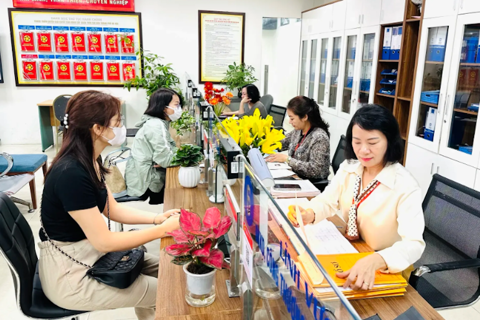Experts urge concrete funding plans for Lang Road upgrade
The huge US$825 million budget for the project has raised public concerns about its feasibility and suspicions over the cost estimate.
Expanding and upgrading Lang Road is a must, as it will complete Ring Road 2 and improve traffic in Hanoi, experts say.
| A bird's eye view of Lang Road along the To Lich River in Hanoi. Photo: Pham Hung/The Hanoi Times |
The Hanoi Department of Transport has mulled a project to widen Lang Road, a section of Ring Road No.2 running from Vinh Tuy Bridge to Nhat Tan Bridge in Hanoi.
Under the plan, the road will be widened from the current 21m to 53.5m to allow a maximum speed of 80km per hour, making it one of the capital's main thoroughfares.
The total investment for the project is estimated at VND21 trillion (US$825 million). This includes VND3.9 trillion (US$153 million) for the construction of a viaduct and VND17.2 trillion (nearly US$676 million) for the widening and upgrading of the existing road.
The road upgrade and expansion would require VND16.7 trillion ($656 million) for land clearing and VND541 billion ($21.2 million) for construction.
According to Nguyen Xuan Tan, Chairman of the Hanoi Bridge and Road Association, upgrading Lang Road is an urgent task.
"It will complete the Ring Road No.2. Otherwise, the tens of trillions of dong invested in the ring road so far will be wasted," he said.
Due to its narrow width and congested traffic, the Lang Road between the Nga Tu So and Cau Giay crossroads is a nightmare to drive on.
Designed for an average of 3,000 vehicles per hour, the road now carries 8,000 vehicles per hour, leading to chronic congestion during the day, even at off-peak times.
"Any plans to divert traffic flows are only temporary solutions and will not be able to ease traffic congestion," Tan said. On the other hand, if we don't widen the cross-section, we won't be able to build the viaduct and complete the ring road.
The Chairman of the Hanoi Bridge and Road Association said the huge cost of land clearance and the impact on thousands of households were the two biggest challenges facing the project.
"There will be consequences if the project developer and contractors fail to make an accurate calculation of land clearing costs," he warned.
Phan Le Binh, deputy Director of OCG Consultancy Company's Vietnam office, said it was necessary to upgrade and expand Lang Road so that Ring Road No.2 could operate at full capacity.
He said that huge land compensation costs are inevitable in major transport infrastructure projects, especially when urban roads are built and upgraded.
"In some cases, the developer needs to build an overpass, elevated road, or tunnel to avoid affecting local residential areas," he says.
Land auction as a possible solution
According to Tran Chung, former Director of the State Agency for Construction Quality Inspection, under the Ministry of Construction, land clearance for this project would be difficult because it would affect families who depend on the road for their livelihoods.
"We need to look at different plans to help them resettle and give them new opportunities to earn money," he said.
Chung also noted that there should be a proper financial plan to fund the project, suggesting that auctioning off land could be a good way.
Accordingly, there will be roadside housing developments to be auctioned off. This would improve the landscape.
The proceeds from the auctions will be used to cover the construction of the road.
Binh of OCG Consultancy Company shared this view, saying that land auctioning could be a way to make the best use of the state capital. "It's not right if only owners of land along the road benefit from the project. It would be too unfair to those who have to be relocated to make way for the road."
Le Trung Hieu, Deputy Director of Hanoi's Department of Planning and Investment, said that while the completion of Ring Road 2 is a must, the project must also balance the interests of those affected.
In this case, applying the differential ground rent rule could be an appropriate solution, he said, adding that the method is already being used in the central coastal city of Danang.
"We need to clear the area along the existing roads to make room for new roads and houses to be auctioned. Then the households affected by the project will have a chance to resettle in their former neighborhood once the project is completed," explained Hieu. The land acquisition is also aimed at redesigning and improving the local landscape, and there will be no more skinny, misshapen houses on the street, he noted.
Experts also argued that Hanoi authorities could expand Lang Road by building new lanes over the To Lich River instead of clearing land. However, this plan could have a negative impact on the city's efforts to revitalize the river and improve the citywide water treatment network.











